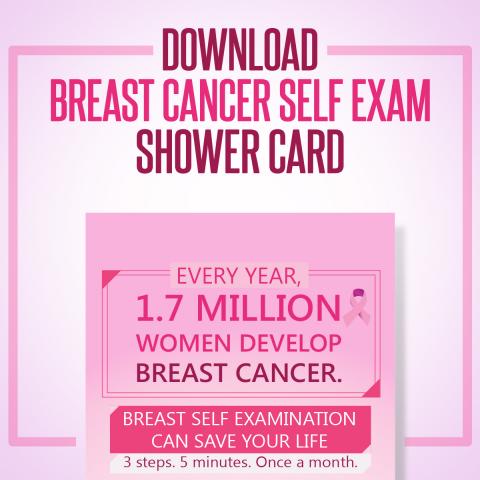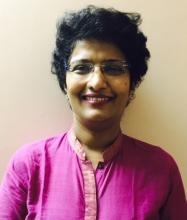
says Dr Geeta Kadayaprath, a Surgical Oncologist and Head of Breast Surgery at Max Super Speciality Hospital, New Delhi. She strongly recommends Breast Self Examination (BSE) as one of the methods for early detection.
How do you spread awareness about breast cancer?
Through lectures, videos and street plays mainly
1. Would you say the awareness has improved over the years?
It has, but in select pockets only, mainly urban. There is no comprehensive, concerted method of creating awareness. Strangely, education has not correlated with the level of awareness. The sense of denial seems to be very strong in educated women and hence the delay in diagnosis.
2. How would you evaluate the difference in awareness between cities and in rural areas, as you also conduct workshops outside city limits?
The situation in urban centres is certainly better than the rural areas. Women in rural areas are not forthcoming about their breast health and besides, if any one is diagnosed with breast cancer, there is very little scope for treatment
Read: Breast Cancer Risk in Urban Educated Women
3. How scientific is breast self examination (BSE)? How do you propagate it?
Since it is dependent on the person who does it, and the kind of breasts one has, it is not easy to objectify BSE. It is only a method to familiarise oneself with one’s breasts. BSE can be taught in person or through videos.
4. Can BSE reduce mortality from breast cancer?
While literature does not show a drop in mortality with BSE, it definitely helps to pick up cancers early. A resource- poor nation like India has a different set of challenges. We see cancers in advanced stages and BSE can certainly help us catch cancer early. Early detection also improves outcomes.
Important: Just 5 minutes a month can save lives
5. At what age should women start BSE?
Earlier is better. One should start familiarising oneself with one’s breasts as early as 21 years. Young breasts are extremely lumpy and may set off false alarms but regular examination will slowly familiarise one with one’s breasts and teach one to ignore what is normal lumpiness.
6. What is the level of awareness on how to do a BSE?
The level of awareness on how to do BSE is very poor. More often than not, women poke their breasts with their finger tips or hold their breast tissue with their fingers and report a lump. The right method to do a BSE is by using the flat of the fingers and systematically covering the entire breast in both sitting and lying down positions.
7. What are the barriers for doing a BSE regularly?
Shyness to touch one’s own self and thinking that it can’t happen to me.
Not treating this as a priority.
8. How can these barriers be overcome?
These barriers can be overcome only by education, lectures, workshops etc
9. ‘Mammography saves lives’: Would you agree?
It does. Mammography has been the tool that the western countries have used to detect breast cancer early. Most of their cancers are detected early and this has served to bring down the breast cancer mortality.
10. Can you mention 5 most common misunderstandings about breast cancer?
MYTHS
- Breast cancer presents as a painful lump- it is usually a painless lump. Rarely is breast cancer associated with pain
- All those who have a family history of breast cancer will also get breast cancer- only 5-10% of breast cancers happen in women with a family history
- Only big breasted women get breast cancer- size has nothing to do with breast cancer
- Men do not get breast cancer- 1% of all breast cancers in a year happen in men
- Anti perspirants cause breast cancer- not true
Read; Is Breast Cancer Infectious?
11. What would you recommend to be the most important methods of early detection in breast cancer?
Mammogram is a good tool to detect breast cancer early but even mammograms can miss upto 20% cancers. An ultrasound breast can complement a mammogram, especially when the breasts are dense. In young women with a strong family history of breast cancer, an MR mammogram may be helpful. Besides the investigations, BSE should be a part of the routine.
Important: Just 5 minutes a month can save lives

12. Do you design your programmes according to the age group of women being addressed? Which age group do you think is the most potent one?
Creating awareness should not be limited by age. The earlier one is aware, the better. However most breast cancers happen between 40-75 years. Awareness should begin at least 5 years before that. In our country we are seeing quite a few women in early ages getting breast cancer, especially in their thirties. The dictum is that if you were to discover a lump, then you must see a doctor and get it investigated
13. Do you have special awareness programmes lined up for 2018? Please tell us about it.
Yes. When one talks about breast self examination, most women do not understand what it is it that one is trying to look for in a breast. Bliss Foundation is an NGO I co founded with one of my patient survivors and it is our mandate to conduct ‘Touch and Feel’ Breast Cancer awareness workshops in Delhi NCR. We would be targeting colleges, school faculty and offices with women and do exclusive workshops on breast self examination for women groups of 20 each. From the trained will emerge trainers and that will allow us to reach out to not just the urban population but also to the slum dwelling and rural population.
Dr Geeta Kadayaprath conducts several awareness programmes to make people aware of breast cancer.







